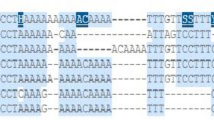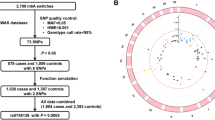Abstract
LncRNAs are of functional long non-coding RNAs, which have been shown to be involved in critical pathways in cancer development. LncRNA-HOTAIR gene overexpression has been reported in several cancers. The aim of this study was to evaluate the associations between two variants of lncRNA-HOTAIR (rs1899663 G>T and rs4759314 A>G) gene polymorphisms and the risk of ovarian cancer (OC) susceptibility. We performed a case and control analysis on two hundred individuals consisting of 100 cases with OC and 100 women cancer-free in East Azerbaijan of Iranian population. To evaluate the association between two SNPs of lncRNA-HOTAIR with the risk of OC susceptibility used the polymerase chain reaction-restriction fragment-length polymorphism (PCR-RFLP) method. We revealed that two SNPs in the lncRNA-HOTAIR gene were significantly associated with the risk of OC. The dominant model of rs4759314 in lncRNA-HOTAIR (AA vs. GA/GG) showed a significantly increased risk with an OR of 10.036 (CI 2.253–44.712, P = 0.000); the recessive model of rs1899663 (TT vs. GT/GG) revealed a significantly increased risk with OR of 0.910 (CI 0.856–0.968; P = 0.002). In addition, our findings demonstrated that the 4759314G (OR 13.500; CI 3.146–57.940; P = 0.000) and 1899663T (OR 3.273; CI 1.433–7.475; P = 0.003) alleles are increased the risk of OC susceptibility. Our findings provide evidence that the specific genetic variants in lncRNA-HOTAIR gene may affect OC susceptibility in an Iranian population.


Similar content being viewed by others
References
Dong X, Men X, Zhang W, Lei P (2014) Advances in tumor markers of ovarian cancer for early diagnosis. Indian J Cancer 51(Suppl 3):e72–e76
Ferlay J, Shin HR, Bray F, Forman D, Mathers C, Parkin DM (2010) Estimates of worldwide burden of cancer in 2008: GLOBOCAN 2008. Int J Cancer 127(12):2893–2917
Hamilton CA, Miller A, Miller C, Krivak TC, Farley JH, Chernofsky MR et al (2011) The impact of disease distribution on survival in patients with stage III epithelial ovarian cancer cytoreduced to microscopic residual: a gynecologic oncology group study. Gynecol Oncol 122(3):521–526
Plagens-Rotman K, Chmaj-Wierzchowska K, Pieta B, Bojar I (2018) Modifiable lifestyle factors and ovarian cancer incidence in women. Ann Agric Environ Med 25(1):36–40
Patch A-M, Christie EL, Etemadmoghadam D, Garsed DW, George J, Fereday S et al (2015) Whole–genome characterization of chemoresistant ovarian cancer. Nature 521(7553):489
Prensner JR, Iyer MK, Sahu A, Asangani IA, Cao Q, Patel L et al (2013) The long noncoding RNA SChLAP1 promotes aggressive prostate cancer and antagonizes the SWI/SNF complex. Nat Genet 45(11):1392–1398
Sun Y, Wang Z, Zhou D (2013) Long non-coding RNAs as potential biomarkers and therapeutic targets for gliomas. Med Hypotheses 81(2):319–321
Eccles SA, Aboagye EO, Ali S, Anderson AS, Armes J, Berditchevski F et al (2013) Critical research gaps and translational priorities for the successful prevention and treatment of breast cancer. Breast Cancer Res 15(5):R92
Haemmerle M, Gutschner T (2015) Long non-coding RNAs in cancer and development: where do we go from here? Int J Mol Sci 16(1):1395–1405
Li J, Cui Z, Li H, Lv X, Gao M, Yang Z et al (2018) Long non-coding RNA HOTAIR polymorphism and susceptibility to cancer: an updated meta-analysis. Environ Health Prev Med 23(1):8
Zhang X, Zhou L, Fu G, Sun F, Shi J, Wei J et al (2014) The identification of an ESCC susceptibility SNP rs920778 that regulates the expression of lncRNA HOTAIR via a novel intronic enhancer. Carcinogenesis 35(9):2062–2067
Xue Y, Gu D, Ma G, Zhu L, Hua Q, Chu H et al (2014) Genetic variants in lncRNA HOTAIR are associated with risk of colorectal cancer. Mutagenesis 30(2):303–310
Bayram S, Sümbül AT, Batmacı CY, Genç A (2015) Effect of HOTAIR rs920778 polymorphism on breast cancer susceptibility and clinicopathologic features in a turkish population. Tumor Biol 36(5):3863–3870
Guo W, Dong Z, Bai Y, Guo Y, Shen S, Kuang G et al (2015) Associations between polymorphisms of HOTAIR and risk of gastric cardia adenocarcinoma in a population of north China. Tumor Biol 36(4):2845–2854
Tang Q, Hann SS (2018) HOTAIR: an oncogenic long non-coding RNA in human cancer. Cell Physiol Biochem 47(3):893–913
Zhao W, Dong L (2018) Long non-coding RNA HOTAIR overexpression improves premature ovarian failure by upregulating Notch-1 expression. Exp Ther Med 16(6):4791–4795
Wu H, Shang X, Shi Y, Yang Z, Zhao J, Yang M et al (2016) Genetic variants of lncRNA HOTAIR and risk of epithelial ovarian cancer among chinese women. Oncotarget 7(27):41047–41052
Qiu H, Wang X, Guo R, Liu Q, Wang Y, Yuan Z et al (2017) HOTAIR rs920778 polymorphism is associated with ovarian cancer susceptibility and poor prognosis in a chinese population. Future Oncol 13(4):347–355
Li J, Liu R, Tang S, Feng F, Wang X, Qi L et al (2018) The effect of long noncoding RNAs HOX transcript antisense intergenic RNA single-nucleotide polymorphisms on breast cancer, cervical cancer, and ovarian cancer susceptibility: a meta-analysis. J Cell Biochem 120(5):7056–7067
Lin Y, Guo W, Li N, Fu F, Lin S, Wang C (2018) Polymorphisms of long non-coding RNA HOTAIR with breast cancer susceptibility and clinical outcomes for a southeast chinese Han population. Oncotarget 9(3):3677–3689
Yan R, Cao J, Song C, Chen Y, Wu Z, Wang K et al (2015) Polymorphisms in lncRNA HOTAIR and susceptibility to breast cancer in a chinese population. Cancer Epidemiol 39(6):978–985
Hassanzarei S, Hashemi M, Sattarifard H, Hashemi SM, Bahari G, Ghavami S (2017) Genetic polymorphisms of HOTAIR gene are associated with the risk of breast cancer in a sample of southeast Iranian population. Tumour Biol 39(10):1010428317727539
Guo L, Lu X, Zheng L, Liu X, Hu M (2016) Association of long non-coding RNA HOTAIR polymorphisms with cervical cancer risk in a chinese population. PLoS ONE 11(7):e0160039
Jin H, Lu X, Ni J, Sun J, Gu B, Ding B et al (2017) HOTAIR rs7958904 polymorphism is associated with increased cervical cancer risk in a chinese population. Sci Rep 7(1):3144
Acknowledgements
The current investigation was extracted from of MS.c (IR: 952003), which was confirmed at the Ahar Branch, Islamic Azad University, Iran. The authors would like to thank all of the subjects who participant in our survey.
Funding
The present survey has no any fund.
Author information
Authors and Affiliations
Corresponding author
Ethics declarations
Conflict of interest
The authors declare that they have no conflicts of interests.
Research involving human and animals rights
This article has involving human participants or animals performed by any of the authors.
Additional information
Publisher's Note
Springer Nature remains neutral with regard to jurisdictional claims in published maps and institutional affiliations.
Electronic supplementary material
Below is the link to the electronic supplementary material.
Rights and permissions
About this article
Cite this article
Saeedi, N., Ghorbian, S. Analysis of clinical important of LncRNA-HOTAIR gene variations and ovarian cancer susceptibility. Mol Biol Rep 47, 7421–7427 (2020). https://doi.org/10.1007/s11033-020-05797-6
Received:
Accepted:
Published:
Issue Date:
DOI: https://doi.org/10.1007/s11033-020-05797-6




